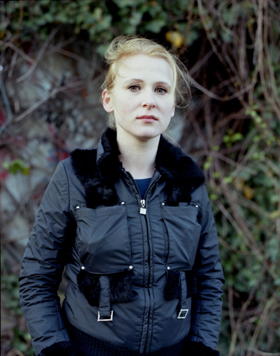Alicja Kwade
Boros Collection
22.10.2011–08.01.2012

Boros Collection
22.10.2011–08.01.2012

|
Intro Views of the exhibition
In her sculptures, installations and photographs, the sculptress Alicja Kwade (born in Katowice, in 1979) takes up art historical traditions, theories of natural sciences and sociological questions in an entirely fascinating way. Consequently she touches both contemporary cultural as well as political and economic themes. Kwade changes and manipulates the physical properties of materials, thereby evoking the surprise effects which disconcert the value we place on experience, our attitudes and our viewing habits. The transformation of the simplest everyday objects by way of an elaborate procedure into apparently luxurious artifacts shows our understanding of materials, objects and ideas. Our ascriptions and perceptions, frequently irrational, are based on cultural patterns, conventions and codes which Kwade undertakes to question with her 'counteractions'. "What interests me are those things and phenomena about which one is not in a position to comprehend [...] these concern the abstract, the absurd, the inexplicable and the not-experienceable, but the nevertheless constantly present [...]". (Alicja Kwade) With the materials she uses, the found pieces and design objects, she also draws on the wealth of forms and ideas of art history: she touches the cosmos of a Marcel Duchamp with his idea of the Readymade. Merging objects and the cancellation of physical attributes are reminiscent of Salvador Dalí and René Magritte. But when viewing Alicja Kwade's clear and minimalist sculptures one may also observe an affinity to Donald Judd and Robert Morris. For this process-oriented further development, Kwade counteracts the aspects of the museal and of conservation, here addressing a fundamental question in the contemporary art world and institutions. Just as Kwade characterizes all art-historical references as derived more from the unconscious, neither does she wish her work to be reduced to an exclusively natural scientific or philosophic approach. It is rather that she draws on these as building blocks so as to exam-ine the identity of things and their relative significance. For this "Kohle (Rekord)" (2006) offers a wonderfully complex example: Kwade takes normal commercial coal and produces a bronze mold from it, covers the single briquettes with gold leaf and positions these 'gold bar' blocks on a base. In this case, too, it is the distorted mate-rial codex which points to the immanent values – both on a monetary as well as ideal level. To this are added the (value) transformations that go along with the artistic creative proc-esses, frequently through the incomprehensible attribution of economic values. Curator: Isabel Meixner |

